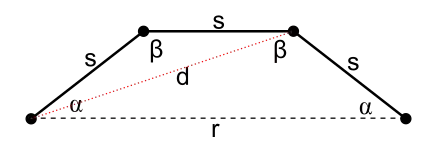I'm trying to solve how much "bend" (angles $\alpha$ and $\beta$) a chain of $N$ equal sized (s) links so that the end to end straight line distance $(r)$ is a given value. I chose to look at this with my high school geometry skills. If it's 2 links, it's easy:
Law of Sines/Cosines makes it easy.
A four bar mechanism wouldn't be solvable, except for my constraints that all links are the same length, and they interior angle is uniform from link to link.
Introducing $d$, noting that $2\alpha + 2\beta = 2\pi$, I could come up with a couple equations, substitute a bunch an come up with:
$$\beta = \cos^{-1}\left(\frac{s² - r²}{2s(s + r)}\right)$$
Works like a charm. Hoping that if I could make it through a 5 sided beast, I'd see a general pattern, I had a go at it.
I came up with the following five equations (and five unknowns) to try:
\begin{align} &2\alpha + 3\beta = 3\pi\\ &\beta= \pi - 2\alpha_1\\ &\alpha= \alpha_1 + \alpha_2\\ &d^2= s^2 + s^2 - 2ss\cos\beta\\ &s^2 = s^2 + d^2 - 2ds\cos\alpha_1\\ \end{align}
(where $\alpha_1$ and $\alpha_2$ are $\alpha$ subdivided to either side of $d$)
I tried to crunch this all, but got to points where it wasn't clear how to isolate it any better.
Which caused me to pause and wonder if I was trying too hard and there was a simpler more direct way to see the solution to the problem.
I'm fine if the answer is "go back and try again to solve your 5 equations, you must've made a mistake". But I was looking for some reassurances that is the right way to go, and that I'll start to see a general pattern that generalizes for $N$ links.
(As a programmer, I could just do a convergent iteration on $\beta$ to hone in on the value that produces $r$, but I was trying to do this generally).


